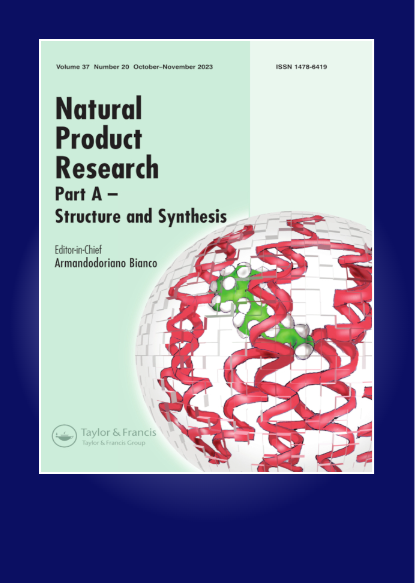Punicalagin improves inflammation and oxidative stress in rat model of pelvic inflammatory disease
IF 1.9
3区 化学
Q3 CHEMISTRY, APPLIED
引用次数: 0
Abstract
Pelvic inflammatory disease (PID) is one of the major public health concerns accounting for 30% of infertility and 50% of ectopic pregnancy cases due to severe inflammation and fibrosis. Punicalagin® are known to exhibit potent anti-inflammatory activity. The aim of this study was to demonstrate the anti-inflammatory and antioxidant effects of Punicalagin®, against pelvic inflammatory disease in rats. Female Sprague Dawley rats (n = 24) were divided into 6 groups (n = 4) as control, PID, prophylactic (low dose and high dose) and therapeutic group (low dose and high dose). PID model was constructed by implanting the rat cervix with mixed microbe (Escherichia Coli and Staphylococcus Aureus) solution. Prophylactic group was gavaged with 3 mg/kg (low dose) and 6 mg/kg (high dose) Punicalagin® daily starting one day before PID induction and therapeutic group was gavaged with 3 mg/kg (low dose) and 6 mg/kg (high dose) Punicalagin® daily starting 1 day after confirmation of PID model. Rats were sacrificed at the end of experiment and samples from upper genital tract were collected for ELISA, antioxidant assay and histopathological examination. According to results, obvious signs of inflammation and oxidative stress including infiltration of neutrophils and significantly raised levels of cytokines, and oxidative stress markers were observed in PID group when compared to control group. Punicalagin® significantly decreased the levels of IL-1β, catalase and lipid peroxidation in both prophylactic and therapeutic groups when compared to PID group. Punicalagin® also decreased the infiltration of leucocytes in uterus of prophylactic and therapeutic group when compared to PID group, as determined by histological examination. On basis of these results, we concluded that Punicalagin® showed anti-inflammatory and antioxidant potential in rat model of pelvic inflammatory disease and could be used as possible therapeutic agent in treatment of PID.
Punicalagin 可改善盆腔炎大鼠模型的炎症和氧化应激。
盆腔炎(PID)是主要的公共卫生问题之一,由于严重的炎症和纤维化,导致 30% 的不孕症和 50% 的宫外孕病例。众所周知,Punicalagin® 具有强大的抗炎活性。本研究旨在证明 Punicalagin® 对大鼠盆腔炎的抗炎和抗氧化作用。雌性 Sprague Dawley 大鼠(n = 24)分为 6 组(n = 4),分别为对照组、PID 组、预防组(低剂量和高剂量)和治疗组(低剂量和高剂量)。PID 模型是将混合微生物(大肠杆菌和金黄色葡萄球菌)溶液植入大鼠宫颈。预防组在 PID 诱导前一天开始每天灌胃 3 毫克/千克(低剂量)和 6 毫克/千克(高剂量)普尼卡因®;治疗组在 PID 模型确认后一天开始每天灌胃 3 毫克/千克(低剂量)和 6 毫克/千克(高剂量)普尼卡因®。实验结束后,大鼠被处死,并采集上生殖道样本进行酶联免疫吸附试验、抗氧化试验和组织病理学检查。结果显示,与对照组相比,PID 组出现了明显的炎症和氧化应激症状,包括中性粒细胞浸润、细胞因子和氧化应激标志物水平显著升高。与 PID 组相比,Punicalagin® 能明显降低预防组和治疗组的 IL-1β、过氧化氢酶和脂质过氧化物水平。组织学检查结果显示,与 PID 组相比,Punicalagin® 还能减少预防组和治疗组子宫内的白细胞浸润。根据这些结果,我们得出结论:Punicalagin® 在盆腔炎大鼠模型中显示出抗炎和抗氧化潜力,可作为治疗 PID 的药物。
本文章由计算机程序翻译,如有差异,请以英文原文为准。
求助全文
约1分钟内获得全文
求助全文
来源期刊

Natural Product Research
化学-医药化学
CiteScore
5.10
自引率
9.10%
发文量
605
审稿时长
2.1 months
期刊介绍:
The aim of Natural Product Research is to publish important contributions in the field of natural product chemistry. The journal covers all aspects of research in the chemistry and biochemistry of naturally occurring compounds.
The communications include coverage of work on natural substances of land and sea and of plants, microbes and animals. Discussions of structure elucidation, synthesis and experimental biosynthesis of natural products as well as developments of methods in these areas are welcomed in the journal. Finally, research papers in fields on the chemistry-biology boundary, eg. fermentation chemistry, plant tissue culture investigations etc., are accepted into the journal.
Natural Product Research issues will be subtitled either ""Part A - Synthesis and Structure"" or ""Part B - Bioactive Natural Products"". for details on this , see the forthcoming articles section.
All manuscript submissions are subject to initial appraisal by the Editor, and, if found suitable for further consideration, to peer review by independent, anonymous expert referees. All peer review is single blind and submission is online via ScholarOne Manuscripts.
 求助内容:
求助内容: 应助结果提醒方式:
应助结果提醒方式:


